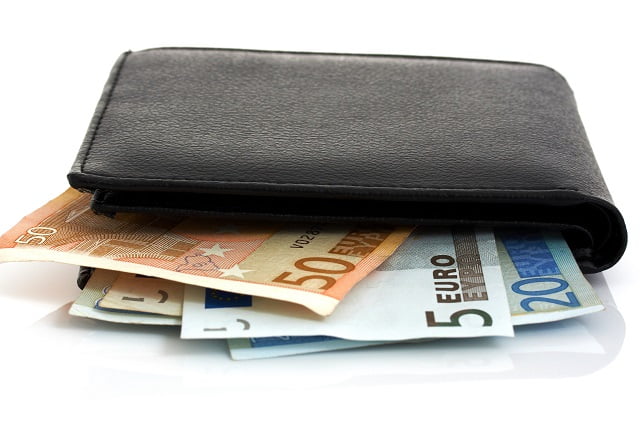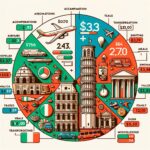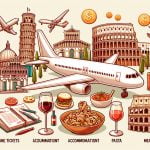Are you planning a trip to Italy and wondering how much money to travel Italy? Italy is a country known for its rich history, stunning architecture, delicious cuisine, and beautiful landscapes.
Whether you are exploring the ancient ruins in Rome, indulging in the art of Florence, or relaxing along the Amalfi Coast, there are budget-friendly options for every traveler. In this article, we will delve into various aspects of traveling in Italy and provide tips on setting a budget, finding affordable accommodations, getting around on a budget, sampling delicious Italian cuisine without breaking the bank, visiting must-see attractions, and much more.
When it comes to traveling in Italy, setting a budget is essential for determining your expenses. From accommodation and transportation to dining and sightseeing, there are various factors to consider when planning your travel expenses. By understanding the cost of each aspect of your trip and finding budget-friendly options, you can experience the beauty of Italy without overspending.
Throughout this article, we will explore different ways to make the most of your trip to Italy while staying within your budget. Whether you are a solo traveler looking for affordable hostels or an adventurous couple seeking unique Airbnb stays, we will provide tips for finding affordable accommodation options.
Additionally, we will discuss transportation options for getting around Italy on a budget and offer advice on sampling delicious Italian cuisine without breaking the bank. So let’s dive in and discover how you can make the most out of your trip to Italy without spending a fortune.
Setting a Budget
When planning a trip to Italy, one of the most important things to consider is how much money you will need for your travel expenses. Setting a budget will help you determine how much you need to save and how much you can afford to spend during your visit. Here are some tips on how to calculate the cost of traveling in Italy.
Research and Estimate Costs
Before setting a budget for your trip to Italy, it’s essential to research the cost of various aspects of travel, including accommodation, transportation, food, and sightseeing. Look into the average prices for hotels or Airbnbs in the cities you plan to visit, as well as the cost of local transportation such as trains or buses. Additionally, consider how much you’re likely to spend on meals and entrance fees for attractions.
Allocate Funds for Different Categories
Once you have an idea of how much money to travel Italy, allocate funds for different categories of expenses. Consider setting aside a specific amount for accommodation, transportation, food, sightseeing, shopping, and miscellaneous expenses. This will help ensure that you have enough money for each aspect of your trip and prevent overspending in one category at the expense of another.
Leave Room For Flexibility
When determining your travel expenses for Italy, it’s important to leave room for flexibility in your budget. Unexpected costs may arise during your trip, so having a contingency fund can provide peace of mind. Additionally, allowing yourself some flexibility with your spending can enhance your overall experience by enabling you to take advantage of spontaneous opportunities or treat yourself to special experiences without feeling constrained by a rigid budget.
Accommodation
When planning a trip to Italy, one of the most important factors to consider is accommodation. There are various options for finding the best hotels, hostels, and Airbnb rentals that suit your budget and needs. The cost of accommodation can greatly impact how much money to travel Italy.
Hotels in Italy range from budget-friendly to luxury options, so it’s essential to do thorough research and compare prices before making a reservation. For travelers on a tighter budget, hostels can be a great alternative, offering affordable dormitory-style accommodations or private rooms. Additionally, Airbnb has become increasingly popular in Italy, providing more affordable and homey options for those who prefer staying in apartments or houses.
Keep in mind that the location of your accommodation can also affect the overall cost of your trip. While centrally-located hotels may be more convenient, they tend to be pricier. On the other hand, staying in the outskirts or less touristy areas may offer more budget-friendly options.
To save money on accommodation in Italy, consider booking in advance to take advantage of early bird discounts or special promotions. Another tip is to be flexible with your travel dates, as rates can vary depending on the season and demand for accommodations. Ultimately, by carefully considering your options and planning ahead, you can find the best lodging that suits both your preferences and your budget for traveling in Italy.
Transportation
Public Transportation
When it comes to getting around Italy on a budget, public transportation is your best friend. Most Italian cities have efficient and affordable public transport systems, including buses, trams, and metros. Rome, Milan, Florence, and Venice all have well-established public transport networks that make it easy to explore the cities without breaking the bank.
Purchasing a multi-day pass or a rechargeable travel card can save you money on individual ticket fares. Additionally, consider taking advantage of regional trains for day trips to nearby towns and attractions.
Ridesharing and Carpooling
For longer journeys between cities or exploring remote areas, ridesharing and carpooling services are great options to consider. Platforms like BlaBlaCar connect drivers with empty seats to travelers heading in the same direction. This not only saves you money on transportation costs but also gives you the opportunity to meet local Italians and fellow travelers along the way.
Biking and Walking
In compact cities like Florence or Siena, exploring on foot or by bicycle can be both budget-friendly and enjoyable. Many Italian cities offer bike-sharing programs, allowing visitors to rent bicycles for short periods at affordable rates. Walking tours are also popular and offer a unique perspective on the city’s landmarks and hidden gems while keeping your transportation expenses to a minimum.
Whether you prefer public transit for urban exploration, ridesharing for intercity travel, or walking and biking for leisurely sightseeing, there are plenty of budget-friendly ways to get around Italy. By considering these options when planning your trip, you can save money on transportation while experiencing everything this beautiful country has to offer.
Food and Dining
When visiting Italy, one of the biggest highlights is undoubtedly trying out the delicious and authentic Italian cuisine. From pasta to pizza, gelato to espresso, there is no shortage of incredible dishes to sample. However, many travelers may be concerned about how much money they will need to budget for food and dining while exploring Italy.
To help you plan your budget for food and dining in Italy, here are some tips and recommendations:
- Opt for aperitivo: Many bars and restaurants in Italy offer aperitivo, which is a pre-dinner drink accompanied by complimentary snacks. This can be a great way to enjoy some delicious bites without spending a lot of money.
- Visit local markets: Head to the local markets to pick up fresh produce, cheese, and bread for a picnic lunch. Not only is this an affordable option, but it also allows you to experience the true flavors of Italy.
- Eat like a local: Avoid touristy restaurants and seek out trattorias and osterias where locals dine. These establishments often offer more authentic dishes at lower prices compared to tourist hotspots.
Additionally, keep in mind that many restaurants in Italy charge a coperto (cover charge) or servizio (service charge) added to your bill. Tipping is not as customary in Italy as it is in other countries, so it’s essential to check your bill carefully before adding an additional tip.
Overall, with careful planning and smart choices, you can enjoy the incredible flavors of Italian cuisine without overspending during your travels.
Lastly, don’t forget that trying street food like arancini (rice balls), panzerotti (fried dough filled with cheese and tomato), or supplì (deep-fried rice croquettes with mozzarella) can be an affordable way to taste traditional Italian snacks while on the go. By incorporating these tips into your travel plans, you can indulge in mouthwatering Italian cuisine without breaking the bank.
Sightseeing
Italy is a haven for history and culture enthusiasts, with its rich heritage and stunning landmarks. When planning a trip to Italy, it’s important to set aside a budget for sightseeing to ensure you don’t miss out on the country’s must-see attractions. Here are some of the top attractions in Italy along with their entrance fees:
- The Colosseum in Rome: One of the most iconic symbols of ancient Rome, the Colosseum’s entrance fee is around 12 euros for adults and free for children under 18.
- The Vatican Museums and Sistine Chapel: Home to some of the world’s most renowned art pieces, admission to the Vatican Museums including the Sistine Chapel costs approximately 17 euros.
- The Leaning Tower of Pisa: A visit to this famous bell tower comes with a fee of about 18 euros for adults and 8 euros for children aged 8 to 18.
In addition to these popular attractions, there are countless other museums, historical sites, and architectural wonders throughout Italy, each with its own entrance fees. It’s essential to factor these costs into your travel budget as they can add up quickly.
While sightseeing in Italy can be an unforgettable experience, it’s also important to find ways to save money on entrance fees. Many attractions offer discounted or free entry on certain days or times, so doing some research beforehand can help you make the most of your budget.
Ultimately, sightseeing in Italy is an integral part of experiencing everything this beautiful country has to offer. By setting aside a portion of your travel budget specifically for visiting attractions and keeping an eye out for discounts, you can make the most of your sightseeing experiences without overspending.
Shopping and Souvenirs
Italy is a country known for its high-quality leather goods, exquisite ceramics, and delicious wines. As such, it’s hard to resist the temptation to bring home a piece of Italy with you. However, shopping for souvenirs can quickly add up and significantly impact your travel budget. In this section, we will explore some budget-friendly ways to bring a piece of Italy home without breaking the bank.
One of the best ways to save money on souvenirs in Italy is by visiting local markets and artisanal shops. These places often offer unique and handcrafted items at more affordable prices compared to touristy areas. Additionally, bargaining is common in Italian markets, so don’t be afraid to negotiate for a better price.
Another budget-friendly option for souvenir shopping in Italy is to look for small, locally-made products that are easy to transport. This could include items such as artisanal olive oil, handmade jewelry, or regional food specialties. Not only are these items often cheaper than mass-produced souvenirs, but they also provide a more authentic representation of the region you visited.
Finally, consider buying souvenirs from non-traditional sources such as museums or historical sites. Many museums offer replicas or prints of famous artworks or historical artifacts at reasonable prices. Not only will you have a piece of Italian culture to take home with you, but your purchase will also support the preservation of these cultural treasures.
| Shopping Tips | Budget-Friendly Options |
|---|---|
| Visit local markets and artisanal shops | Unique and handcrafted items at affordable prices; opportunity to bargain |
| Look for small, locally-made products | Cheaper than mass-produced souvenirs and offers more authenticity |
| Buy from museums or historical sites | Replicas or prints of famous artworks at reasonable prices; supports cultural preservation |
Miscellaneous Expenses
When planning a trip to Italy, it’s essential to consider the miscellaneous expenses that may arise unexpectedly. These costs can add up quickly and impact your overall budget for the trip. In this section, we’ll explore some of the common unexpected expenses you may encounter while traveling in Italy and provide tips for saving money along the way.
One of the most significant miscellaneous expenses to consider when traveling in Italy is tipping. While tipping is not mandatory in Italy, it is customary to leave a small tip for exceptional service at restaurants, hotels, and for tour guides. It’s important to factor in these additional costs when setting your budget for meals and guided tours.
Another often overlooked expense is public restrooms. In many tourist areas in Italy, public restrooms require a small fee for use. While the cost is usually minimal, it can add up over the course of your trip, especially if you’re traveling with a family. Planning ahead and having spare change on hand can help alleviate this unexpected expense.
Additionally, unforeseen transportation costs such as taxis or extra baggage fees on trains should also be considered when budgeting for your trip to Italy. By researching and planning your transportation options in advance, you can avoid unnecessary fees and save money during your travels.
| Unexpected Expenses | Tips for Saving Money |
|---|---|
| Tipping for service | Research tipping customs before your trip |
| Public restrooms | Carry spare change for restroom fees |
| Unforeseen transportation costs | Plan and research transportation options in advance |
By being aware of these potential unexpected expenses and implementing money-saving strategies during your travels in Italy will help ensure that you have a memorable experience without blowing through your budget.
Conclusion
In conclusion, traveling to Italy can be a truly enriching experience that offers the chance to explore breathtaking landscapes, indulge in delectable cuisine, and immerse oneself in rich history and culture. However, for many travelers, one of the first questions that come to mind is how much money is needed to travel Italy.
After evaluating our budget for various expenses such as accommodation, transportation, food and dining, sightseeing, shopping, souvenirs, and miscellaneous costs, we have a better understanding of the total cost of our trip.
Setting a budget before embarking on your Italian adventure is crucial for managing your travel expenses. By researching and planning ahead for costs such as accommodation and transportation, travelers can find affordable options without sacrificing comfort or convenience. Additionally, embracing local markets and street food vendors can provide a more authentic experience while also saving money on dining. Furthermore, taking advantage of free or discounted attractions and activities can help offset the overall cost of sightseeing in Italy.
In summary, with a bit of careful planning and prioritization of expenses, it is possible to enjoy a memorable trip to Italy without breaking the bank. From sampling delicious gelato flavors to marveling at iconic landmarks such as the Colosseum and the Leaning Tower of Pisa – there are countless ways to savor the beauty of Italy without overspending.
By incorporating these budget-friendly tips into your travel plans, you can make the most of your time in Italy while staying within your financial means. Ultimately, with the right approach to budgeting and spending wisely throughout your journey, experiencing all that Italy has to offer is well within reach.
Frequently Asked Questions
Is It Better to Carry Cash or Card in Italy?
In Italy, it is generally better to carry both cash and card. While credit and debit cards are widely accepted, especially in larger cities, some smaller establishments may only accept cash. It’s always good to have some euros on hand for these situations.
Should I Bring Money to Italy?
Yes, it’s a good idea to bring money to Italy. While you can use ATMs to withdraw euros once there, it’s helpful to have some cash on hand upon arrival for immediate expenses like transportation or meals. Be sure to notify your bank beforehand about your travel plans to avoid any issues with using your card abroad.
Can I Use US Dollars in Italy?
It’s not common to use US dollars in Italy. The official currency is the euro, so it’s best to exchange your dollars for euros either before your trip or upon arrival. While some tourist-centric places may accept US dollars, it’s generally preferred and more convenient to use the local currency.

I’m a passionate traveler, writer, and Italophile. My fascination with Italy’s history, art, and culture has led me on countless adventures across the Italian landscape. Through “I Live Italy,” I share my love for this extraordinary country and aims to inspire others to explore its boundless beauty.





